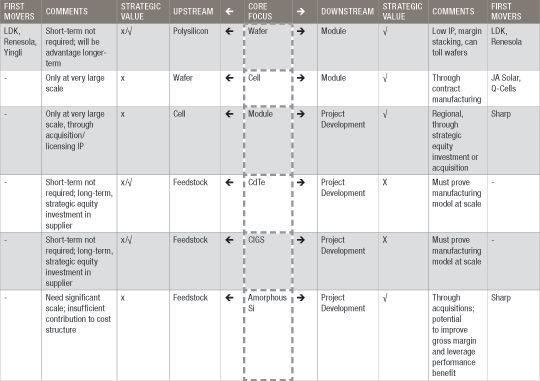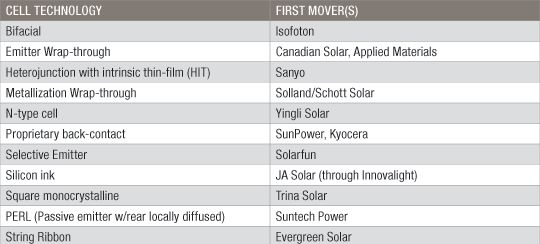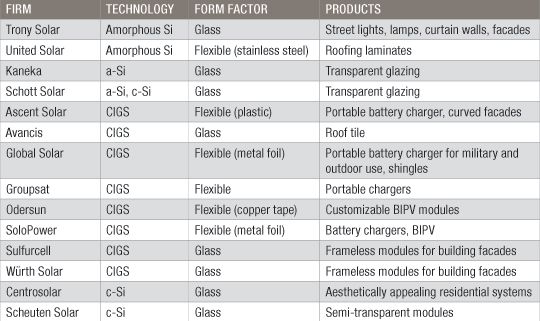An idea that has been stressed numerous times in recent months is that PV components (especially standard c-Si PV) are becoming commoditized to an ever-increasing degree, and will continue to do so in the future. Naturally, this gives producers in regions such as China and Taiwan a natural advantage, thanks to their low labor, utility, overhead, and capital costs. Although other factors do play some role in a buyer’s choice (time-in-market, bankability, sales presence, brand, geographic origin), these will still be secondary to the overriding factor: price.
The obvious question is what manufacturers in other regions can do to compete with the deluge of cheap modules that will continue to flow out of low-cost locations in the future. Although 90%-plus expected growth in 2010, some degree of customer stickiness, and a shortage of bankable, low-cost modules all serve to ensure robust sales and factory utilization for high-cost manufacturers, GTM Research analytics indicate that this certainly cannot be taken for granted in future years, as China/Taiwan c-Si capacity keeps ramping harder than the rest, and higher-cost producers are forced to compete for a limited segment of demand (for more on that thesis, see this article). In general, some form of differentiation is required to offset the low-cost/high-scale advantages of the Chinese: a bare-bones pure-play standard c-Si cell or module business model, which many Western producers still have, simply will not stand a chance in the long run. This is clearly illustrated by a look at capacity factors for pure-play c-Si module firms, which GTM Research’s analysis projects to drop from 68% in 2010 to 31% by 2013.
At a high level, firms can adopt one of two strategies (which are not by any means mutually exclusive) to improve their competitive positioning relative to low-cost firms, as well as to their higher-cost peers: either take measures to reduce the delivered cost of electricity substantially, or attempt to enter markets and applications that support higher module prices. These strategies are elaborated upon in more detail below.
1. Vertical Integration
This can involve integrating upstream or downstream relative to where a firm is currently placed in the value chain. The table below details key upstream and downstream integration considerations by value chain position and assesses the strategic value of each.

i. Wafer-polysilicon integration: Trends indicate that a growing number of manufacturers have resorted to an integrated wafer-polysilicon model. These include early movers such as REC, M.Setek, and MEMC, along with more recent additions to the field (LDK, Renesola, Yingli). While driving down the production cost of polysilicon to a level that provides a competitive advantage takes time and considerable expertise, firms with a high-quality in-house polysilicon supply will have a definite edge over other wafer suppliers in the long run. However, given ample polysilicon supply over the next few years, this is a less pressing directive and more of a long-term consideration.
ii. Module assembly: Given that module assembly involves little or no IP, entering module assembly allows both cell and wafer firms to potentially expand their margins with little or no risk, and gives them an advantage over both pure-play wafer/cell and module firms. At the same time, since it is a low-value-add step, there is a definite benefit in farming module assembly out to a contract manufacturer, as it negates capital risk and modules can be assembled near key markets, which would reduce shipping costs to end-customers. In the case of wafer firms, cells can be procured via tolling arrangements with cell producers, as done by Renesola and LDK.
iii. Project development: For module firms with a local presence in strong markets (Germany, Italy, U.S., Canada), this could be an important strategy via which to stay competitive with Asian suppliers, as the loss in margins on expensive components can be made up by margins on project development (a practice that has worked successfully so far for SunPower). This is also a strategy by which sales channels can be created in emerging markets, when other options have proven to be unsuccessful.
In particular, downstream integration may make sense for amorphous silicon manufacturers with large corporate parents, as the balance sheet of the parent can go a long way towards securing low-cost capital, as well as potential EPC services (e.g., Mitsubishi, Sharp, Hyundai, Kaneka, Chint, QS Group). A downstream-integrated amorphous silicon firm would in theory have a significant competitive advantage in emerging markets such as India and China, where the high temperature coefficient of a-Si gives it a performance (energy yield) advantage over other technologies, which can be difficult to convey to customers when trying to bake that into the module price. Entering project development is not an option limited to module suppliers: the arguments presented above can apply equally well to wafer and cell manufacturers, as long as they either have a strong domestic presence or acquire a local developer.
2. Technology Differentiation
Technology differentiation is only important insofar as it can help drive down the delivered cost of electricity to the end-customer (by way of lower BOS costs) or improve energy density for space-constrained regions. The latter is a key reason behind SunPower’s success in the U.S. residential market (along with its established network of dealers). In theory, European c-Si firms should be enjoying an advantage on this front, as they have been in the market longer than most Chinese firms; however, most European cell producers are characterized by a lack of the kind of technological innovation that can add value on top of what their cell equipment vendors can provide. In fact, it is actually the large Chinese firms (Suntech, Yingli, Trina) that have taken the lead in introducing high-efficiency initiatives, and some of them have undertaken collaborative efforts with leading European research laboratories (ECN).
Going forward, whether and how Western firms can improve their competitive positioning through technological innovation will play a crucial role in determining their success, as this is one way in which they can offset the low-cost advantage of Asian manufacturers. However, pulling this off in crystalline silicon PV is easier said than done, as it is a technology with a high degree of maturity. Still, a number of options can be pursued, some of which are detailed below. Many of these approaches are already being pursued by individual firms, some of which are European.
On the thin film front, there is still much room for improvement for key manufacturing parameters such as yields, throughputs, and efficiencies. This is where Western firms can take the lead over firms in low-cost locations, and doing so could confer a direct benefit in terms of manufacturing costs. This has been the case for difficult-to-develop technologies such as CdTe and CIGS, which are almost completely the domain of American and European firms. Similar opportunities exist for tandem-junction Si, where Sharp has taken the lead, due to the development of manufacturing equipment in conjunction with Tokyo Electron that has given them a clear lead in efficiencies (expected to be 10% in 2011). However, most thin film firms are already well aware of the need for constant technology innovation to stay competitive, and even firms that have purchased turnkey equipment are pouring significant funds into R&D to keep abreast with the competition.

3. Product Differentiation
The overwhelming majority of PV suppliers today compete in an end-market where the value of their products is measured almost solely on the basis of the cost of the electricity they create. However, recent years have seen the birth of alternative PV end-markets, where demand drivers can be very different. Examples of these include the building-integrated PV (BIPV) space, where the module also functions as a component of the envelope (e.g., in facades, curtain walls, shingles, or windows), and specialty applications, such as portable solar chargers for the military and consumers. Such applications are generally less price-sensitive than “standard” PV modules, as such variables as form factor, aesthetic qualities, and ease of integration also play an important role in buyers’ decisions. This provides an opportunity for firms that possess the capabilities to cater to these markets, and bypass the “rat race” of commoditized solar.
Firms for whom these sorts of alternative markets and applications would be a good fit would generally have the following qualities:
i. A differentiated technology or form factor, such as a flexible substrate, frameless modules, or modules with high aesthetic value
ii. Small-to-mid-size in terms of current capacity, as the markets for emerging PV applications are still relatively small and there is a definite ceiling on the addressable market, especially in early years
iii. Product design, technology, and cost-reduction capability to increase the size of the addressable market over time
iv. Strong local presence in key markets driving demand for such products, such as France, Germany, and the U.S.
The points above make it clear that solely pursuing these applications is not an ideal fit for all producers in the market. Still, for a number of smaller, higher-cost firms, differentiated products and alternative markets may be the only way to go, as the cost gap between themselves and larger, cheaper producers is only likely to widen over time. In many ways, this would mirror trends witnessed in other manufacturing sectors such as consumer electronics and electrical appliances.
The table below identifies the firms that have taken the lead in developing products for alternative markets. It is clear that CIGS, with its ability to be deposited on flexible substrates and still deliver 8% to 9% efficiency, has taken the lead on the product development front, and many higher-cost manufacturers have been quick to realize the significant challenges involved in competing with low-cost Chinese c-Si production. Going forward, one would expect an increasing number of European c-Si and a-Si firms to adopt this business model as well, although glass substrates will limit their ability in terms of applications.

4. Shifting the Production Base
A few prominent Western manufacturers (BP, SunPower, Evergreen) have reacted to the increasingly cost-sensitive manufacturing environment by deciding to outsource production to OEMs such as Jabil, Jiawei and Flextronics. By and large, the firms that have elected to do so have been American-based, and this trend has not really caught on in Europe. As the regional cost spread continues to widen over time and margin pressure on European firms increases, they will be forced to contemplate shifting their manufacturing base to lower-cost locations, either through OEMs, or by establishing in-house facilities in low-cost locations (as Q-Cells and REC have done). While contract manufacturing makes sense for module assembly, cell and wafer manufacturing are technologically more demanding and better left to in-house expertise.
Permanently shuttering factories in the country that serves as a company’s home base is a move that involves serious considerations, as it can result in significant domestic job losses and public relations issues, and could serve to divorce the firm’s headquarters from its production center. Many German firms, with a proud history of “made in Germany” manufacturing, would also consider such a move to undermine their core values and competency, and dealing with the machinations and bureaucracy of a developing country can be a significant challenge. Moreover, developing in-house production capabilities offshore only carries an advantage when done at significant scale. Firms with limited ability for expansion, therefore, are better off maintaining their mid-sized production bases in the developed world and pursuing other strategic options, such as designing technology that can be licensed or developed in conjunction with larger firms, integrating downstream into module assembly or project development, or pursuing new applications and markets.
For larger Western firms that are looking to expand more ambitiously, the choice is simple, but not easy: As the experience of Q-Cells, First Solar, and REC shows, there are huge cost benefits to locating manufacturing in developing regions. A number of such countries, such as Malaysia and Singapore, also have a relatively stable political climate and economic infrastructure and a skilled workforce. The ideal strategy here would be to locate sizeable cell and wafer capacity in such regions, while module assembly will again be a toss-up between a centralized location (REC), locating it close to end-demand (Sharp, Kyocera), or outsourcing to OEMs (Q-Cells modules), and will depend heavily on available incentives, the firm’s target markets, and its manufacturing economics.
The table below provides a summary of the strategic options available to wafer, cell, and module suppliers via which to improve their competitive positioning, along with the types of firms these strategies are suited to, examples of first movers, and prospective adopters over the next few years.

This is an excerpt from GTM Research's recently published global PV supply chain report, PV Technology, Production and Cost Outlook: 2010 - 2015. The report addresses technical characteristics, production/capacity volumes, facility-specific manufacturing costs, supply-demand dynamics, and competitive positioning across all relevant PV technologies and nearly 200 wafer, cell, and module firms. For more on the report, go here.



